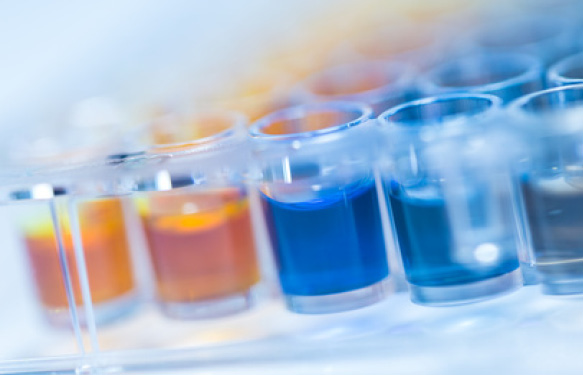
Matrix components are key R&D elements in pharmaceutical and cosmetology with tremendous impacts on tissue regeneration, skin repair, wound healing, allergy and inflammation, surgery, ageing diseases…
Collagen, Elastin, and Proteoglycans are major components of the Extracellular Matrix (ECM) where they form highly complex networks. ECM builds up an environment which supports surrounding cells and plays a crucial role in cell-to-cell communication, cell adhesion, and differentiation.
The monitoring of ECM components during experimental approaches requires robust and user-friendly in vitro assays. In the past experimental methods (e.g. soluble collagen measurement) were laborious and based on the use of harmful chemicals. Today, easy-to-use and straightforward methods with colorimetric read-outs are used daily.
ECM components #1: Soluble and insoluble Collagen
The Sircol Assay (Biocolor) is a quantitative dye-binding method designed for the analysis of Acid-Soluble Collagen (ASC) and Pepsin-Soluble Collagen (PSC) by absorbance readings within the range 520-570 nm. Furthermore, a variant of this kit uses mild acid and temperature treatment for 2 to 3 hours to denature insoluble collagen fibers and make them measurable with the Sircol dye. Types I to V mammalian collagens can be measured with the assays.
By applying both assays, the Sircol Collagen assay and the Sircol INSOLUBLE Collagen Assay, three collagen fractions can be differentiated (See Fig.1):

- Collagen soluble in cold dilute acid
- Collagen soluble in cold dilute acid and pepsin
- Insoluble collagen
Of course, by adding the results together a value for the “Total Collagen” in a sample can be established.
ECM components #2: Glycosaminoglycans and Proteoglycans
The Blyscan assay (see flowchart Fig. 2) is a quantitative dye-binding method for the analysis of sulfated proteoglycans and glycosaminoglycans.
Test material can be assayed directly when present in a soluble form, or following papain extraction from biological materials. The assay can be used to measure the total glycosaminoglycans content and can also be adopted to determine the O- and N-sulfated glycosaminoglycan ratio within test samples.

The assay can be used from:
- fibrous and hyaline cartilages
- arteries, heart, lung, skin and other material containing extracellular matrix, (connective tissue) and solid tumours (results see Fig. 3)
- extracellular matrix components that may be released by live cells into the culture medium, some of which can be attached to cell culture plasticware
- soluble glycosaminoglycans from synovial fluid, urine and gel chromatography fraction aliquots
ECM components #3: Elastin
Similar to the Sircol and Blysan assays, the Fastin assay is a based on a colorimetric method utilizing the Fastin dye which binds to elastins released into tissue culture medium and extracted from biological materials. The kit measures:
- soluble tropoelastins
- athyrogenic elastins
- insoluble elastins (following solubilization to elastin polypeptides [α-elastin, κ-elastin])

Fig. 4: The extracts shown were pooled and expressed as μg elastin per 10 mg wet tissue.
Typical results obtained with diverse mouse tissues are shown in Fig. 4.
Monitoring other ECM components?
Besides the colorimetric assay presented above, we can also offer ELISA based assays from ECM components such as hyaloronic acid, fibronectin and laminin.




5 responses
hello~
I have some questions to Biocolor.
I have bought Sircol TM soluble collagen assay cat# s1000.
And I’d like to measure a concentration of soluble collagen from rat tissue of salivary gland. However the measured values were too low (about 5~6 ug/mg) in my hand even I totally followed your protocol including collagen isolation and concentration protocol. Therefore I could not be sure whether this value is aceptable or not. Is there any reference for this organ of rat species in your company ?
In addition, I used up only Acid-Salt Wash reagent among assay kit components.
Can I know the exact component of Acid-Salt Wash reagent to make it in my lab?
Dear Kyungshin,
Our expert is going to contact you directly by e-mail.
Regards,
Philippe
Dear Sir,
We are a french medical device company specialized in xenograft production for abdominal surgery.
We are interested in your collagen colorimetric assay. Would it be possible to have some more details? ECM has to be digested before using your test or are your providing a complete assay?
regards
A. Peres
Dear M. Peres,
Thank you very much for your question regarding our SIRCOL collagen assay (for research use).
For tissue samples the Acid/Pepsin Extraction procedure requiring over night incubation at 4°C is the recommended one.
Some older age samples may require two enzyme extractions to fully recover pepsin soluble collagen.
You will find more details in the protocole on sample preparation. For insoluble collagen, tissue samples are exposed to dilute acid at a temperature of 65°C for not less than 2 hours and for not more than 3 hours. Under these conditions, the insoluble collagen fibres are converted to water soluble denatured collagen, without generating the release of hydroxyproline residues.
I hope I have addressed your question. Feel free to come back to us if you needed more information. We will be happy to help.
Kind regards,
Isabelle
Dear Sir/Madam,
My name is Johan Gustafsson and I’m a PhD student for Jens Nielsen at Chalmers University of Technology, Sweden. I’m looking for a quantification of sugar vs protein in tumor ECMs for the purpose of metabolic modeling. So, I’m not interested in measuring differences across conditions, but rather to get the absolute dry mass ratio between protein and sugar. Do you have any assay that can help with this, or know where I can find such published data? I have tried for quite some time without success. I would also like to be able to measure the total dry mass weight of cells vs ECM in tumors, if you have any advice for that?
Kind regards
Johan